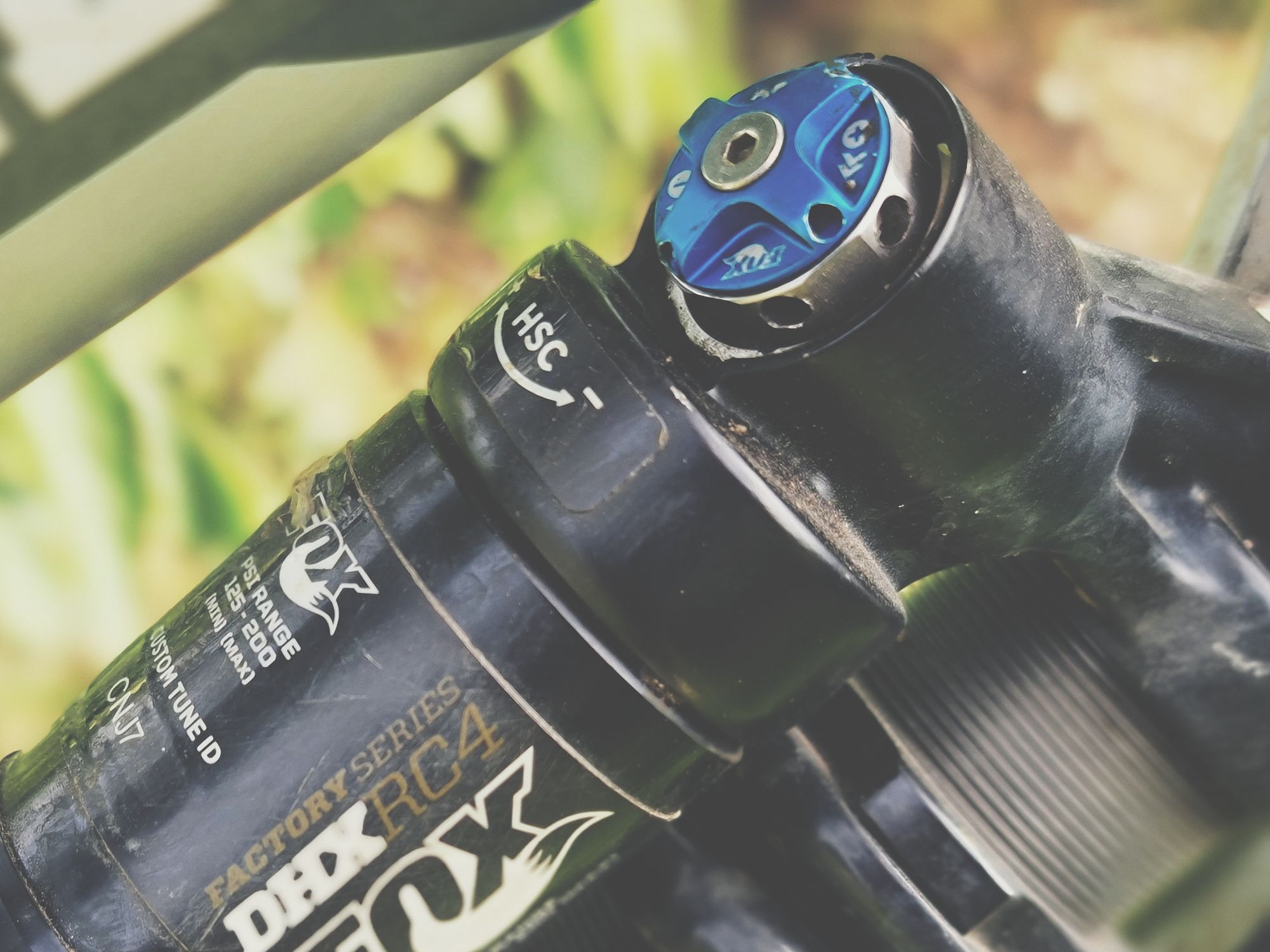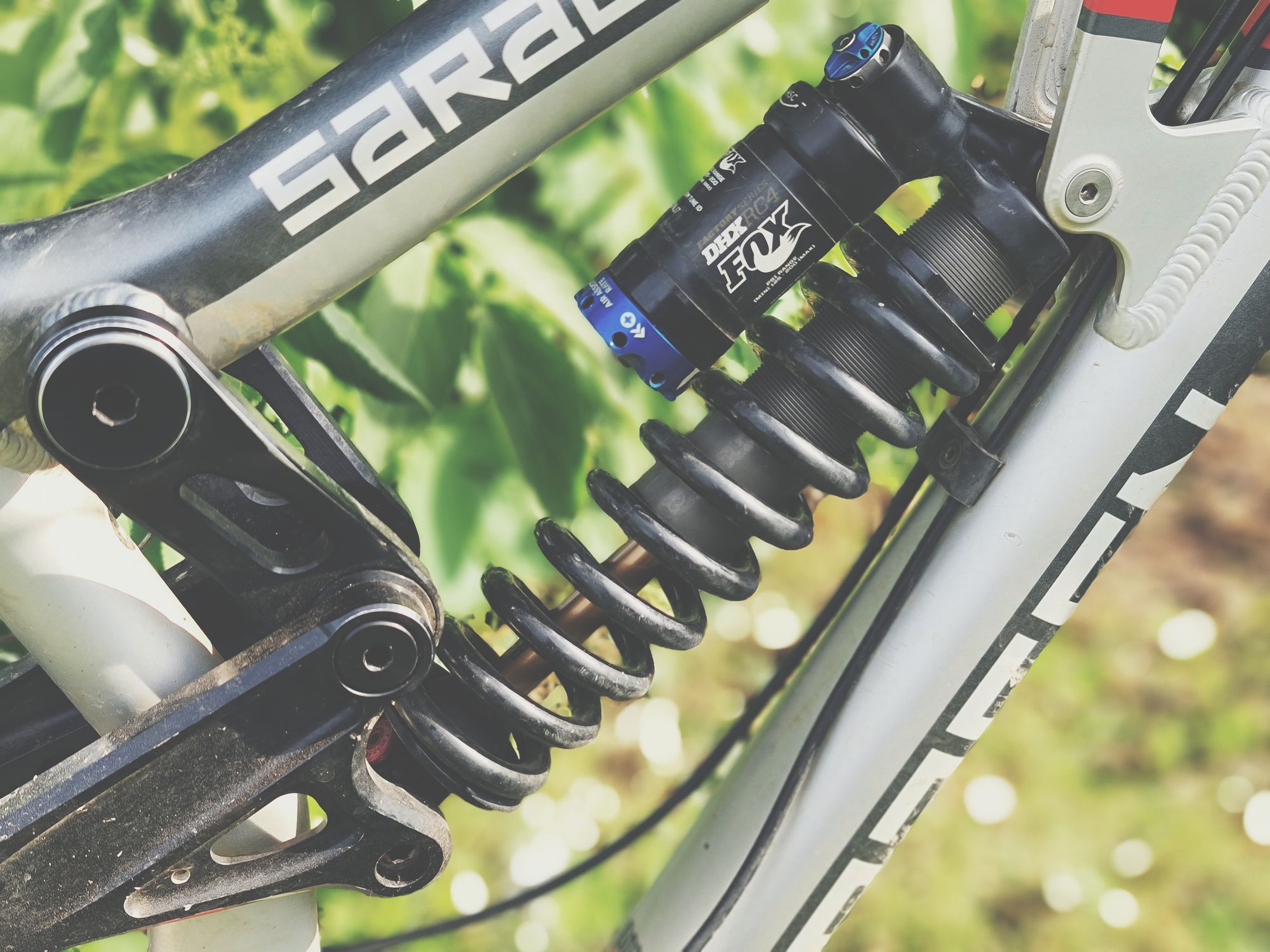The Fox DHX RC4 stopped being produced in 2015, and was replaced by the DHX2. So why review a 5 year old shock? Well, there are plenty around on the second hand market and we think that it's actually still one of the best shocks we've used. They can be picked up now very very cheaply so are an absolute bargain.
We used the RC4 for around 10 months, at fast rocky bike parks as well as natural wet muddy trails , with some hucks to flat thrown in as well to properly push the shock. It was mounted to a DH bike, so used on uplift, however it was also used to pedal when no uplift was available (such as now when everything is shut due to Corona!)

Design
Compared to the Cane Creek DB IL we reviewed , the RC4 is substantially heavier and comes in a larger package with the addition of the piggy back. Other than that it's pretty similar to every other shock out there, just with blue accents rather than the now in vogue Fox orange.
Setup
The DHX RC4 comes with high and low speed compression dials, as well as a single rebound dial. The DHX2 has high and low speed rebound, but in reality this isn't as big a deal as having separate high and low speed compression adjustment. See this excellent Vorssprung Suspension video for more information on that. Both the compression dials make noticeable difference when moved a few clicks but there is still a good amount of range between being fully open and closed.
What makes the RC4 so interesting is the big blue dial on the piggy back, and the shrader valve that sits in the middle of it. One of the benefits air shocks have over coil is the ability to quickly set your spring rate to precisely what you want it to be. With coil shocks, you need to work with the 25lb or even 50lb increments that springs come in, and adjusting the spring rate means removing the shock from the bike. With the RC4 Air Assist you can add between 125 and 200psi to the can which effectively increases the spring rate. This works really well, with again noticeably firmer setup with full 200psi compared to the minimum.
The icing on the cake is blue Air Assist rate dial. Another benefit that air shocks have over coil is that air ramps up progressively as the shock moves through its stroke, which makes harsh bottom outs less likely (depending on your frames suspension design). The Air Assist dial expands or reduces the volume of the air assist chamber, meaning that when its set to the smallest it ramps up the support more as the shock is compressed. At both extremes the difference was again noticeable, and we preferred it all the way closed to give the most progressive setup possible.

Performance
So how did a shock which design dates back to 2009 compare to its modern equivalents?
To start off, it's worth noting that in the last 10 years, most development in mountain bike suspension has focused on improvements on the air side of things. On trail, enduro and even DH bikes coil shocks were becoming a rarer sight to see up until a few years ago. This was down to shocks such as Fox's X2 making huge jumps in small bump sensitivity and consistency on long descents thanks to larger oil volumes and can size allowing heat to dissipate easier. Rockshox have pretty much abandoned coil (when was the last time you saw a Vivid coil on a bike?) and the Cane Creek DB IL is pretty much on the only major coil shock to come out in the last few years from the major manufacturers that brings anything new to the table,and even then thats just "its a bit smaller and lighter and has a climb switch".
This has left the smaller companies such as Push with their 11-6 and Storia with their EXT to be the vanguard when it comes to coil shock enhancements. From people we've spoken to who have these shocks, they've all been blown away by there performance, but that all comes at a huge cost at just under £1000 each.
All of that said, the DHX RC4 holds up very very well. Small bump is the same as every other coil we have used - unbeatable. Fast rocky sections the shock stays glued to the ground giving that nice 'heavy' rear end feeling. We've only tested the RC4 on one bike with a progressive-linear ratio so it's hard to make accurate analysis of how a shock performs in the mid-stroke, but it's the bottom out where the RC4 shines. The air adjust works wonders, and with the can around the middle pressure, but the volume reduced fully it makes even the biggest hits disappear. With a linear linkage design at the end of the travel on a normal coil shock the only way to avoid harsh bottom outs would be to increase spring rate, add compression damping or add a higher viscosity oil. All of these have a negative impact on small bump and the rest of the stroke.
There is no climb switch option, so if you want to firm things up for pedaling your only option is to wind on some more low speed compression. Unlike the DHX2 however, on the DHX this is tool free, meaning less faff on the trail.
Performance wise the amount of adjust ability on the RC4 means you can set it up just how you want. In many ways the DHX2 could be seen as a step backwards, as the air assist has proven to be so versatile in getting the ride characteristics you want. When compared to other shocks we've used for a long period, the RC4 comes out pretty much on top on all except weight.
Servicing
Fox get lots of points for having detailed service guides on the website. The one for the DHX RC4 being no exception. It's worth noting that the DHX doesn't need any nitrogen, unlike the DHX2 meaning it's easier for the home mechanic to perform a rebuild if required. We have not had to service our shock however, so can't comment on how easy the task is.

Issues
The only issue we had was that due to the placement of the rebound dial and how our test frame is designed it meant adjusting the dial was a bit fiddly. Other than that the shock has performed flawlessly.
Overall
With coil shocks making a comeback in the trail and enduro bike segment, the DHX RC4 makes for an ideal candidate for those who have pre-metric frames and can hunt one down in the correct size. Performance wise the RC4 is as good as any other coil shock currently made by the major manufacturers, and the ability to tune the end stroke and support means it's compatible with a wider range of frames than say the Cane Creek DB coil series, the DHX2 or DVO Jade. With the environmental costs of the constant clamour for the 'latest and greatest', it is sometimes wise to look back at what we currently have and ask 'is the shiny new actually that much better and worth the cost, both financially, as well as ecologically?' In the case of the Fox DHX RC4, the answer most certainly is - no.
